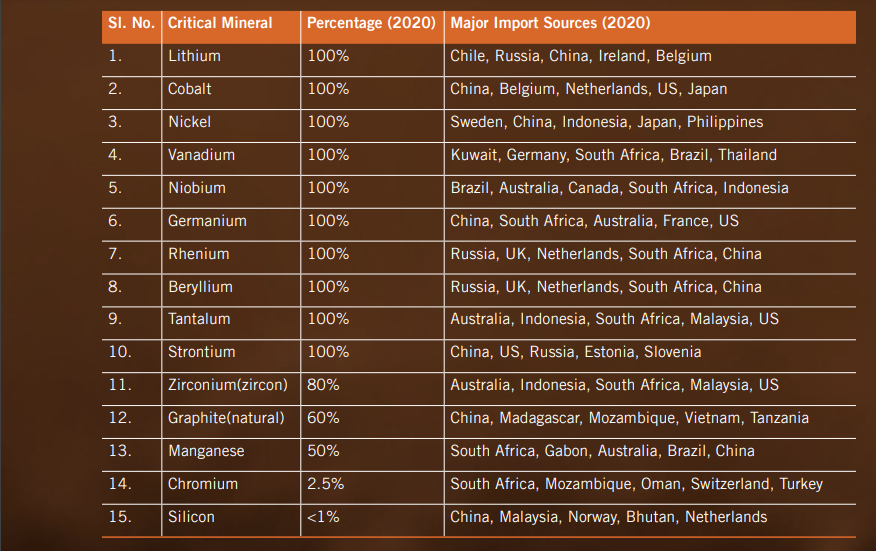Description

Disclaimer: Copyright infringement not intended.
Context
Cabinet approves royalty rates for mining of 12 critical and strategic minerals.
Details
- The Union Cabinet approved the amendment of Second Schedule to the Mines and Minerals (Development and Regulation) Act, 1957 ('MMDR Act') for specifying rate of royalty in respect of 12 critical and strategic minerals, viz., Beryllium, Cadmium, Cobalt, Gallium, Indium, Rhenium, Selenium, Tantalum, Tellurium, Titanium, Tungsten and Vanadium.
Critical minerals
- Critical minerals are those minerals that are essential for economic development and national security.
- A mineral is labelled as critical when the risk of supply shortage and associated impact on the economy is (relatively) higher than the other raw materials. The risk of supply shortage would ideally capture import dependence, recycling potential, and substitutability of the mineral in question.

Significance
- Critical minerals are the foundation on which modern technology is built. From solar panels to semiconductors, wind turbines to advanced batteries for storage and transportation, the world needs critical minerals to build these products.
- Simply put, there is no energy transition without critical minerals, which is why their supply chain resilience has become an increasing priority for major economies.
- India’s future economic prosperity will depend on how well we can use our vast energy and mineral resources to play to our strengths, and how well we can adapt to follow the global market shift towards zero emissions.
India’s perspective
- The Indian economy has undergone a transformative process of New Age reforms in the last decade. These diverse policies converge toward improving the economy’s overall efficiency and realizing its growth potential.
- The use of technology, in particular digital technology, underpins the reforms. The future global economy will be powered by technologies that depend on minerals such as lithium, graphite, cobalt, titanium and rare earth elements.
- These are essential for the advancement of many sectors, including hightech electronics, telecommunications, transport, and defence.
- They are also vital to power the global transition to a low-emission economy, and the renewable energy technologies that will be required to meet the ‘Net Zero’ commitments.

Geo -political situation and the supply chain
- The evolving geo-political situation presents an opportunity for India to benefit from the diversification of global supply chains.
- The last few years have exposed multinational firms and countries to unprecedented risks due to global trade tensions, pandemic-induced supply chain disruptions, and the conflict in Europe.
- Firms were exposed to the risk of concentrating their production in a single country. Therefore, given the global policy uncertainty, multinational firms are gradually exploring strategies to diversify their production bases and supply chains.
- The United Nations Conference on Trade and Development (UNCTAD), in one of its reports, mentions that ‘reshoring, diversification, and regionalization will drive the restructuring of global value chains in the coming years’.
Critical Minerals in India
- Rare Earth Elements (REEs): India possesses significant reserves of rare earth elements essential for high-tech industries such as electronics, renewable energy, and defense. Monazite, found in beach sands along the eastern and southern coasts, is a primary source of REEs.
- Cobalt: With increasing demand for cobalt in lithium-ion batteries for electric vehicles and electronics, India is exploring opportunities to secure cobalt resources. While domestic reserves are limited, efforts are being made to diversify sources through international partnerships and investments.
- Graphite: Graphite is indispensable for lithium-ion batteries, steelmaking, and lubricants. India has substantial graphite reserves, primarily in Madhya Pradesh, Jharkhand, and Odisha, making it a potential key player in the global graphite market.
- Platinum Group Metals (PGMs): PGMs like platinum, palladium, and rhodium are critical for catalytic converters in automobiles, fuel cells, and jewelry. India relies heavily on imports for PGMs, prompting initiatives to explore domestic reserves and invest in recycling technologies.
- Lithium: As the demand for lithium-ion batteries surges with the rise of electric vehicles and renewable energy storage, securing a stable supply of lithium is paramount. India is actively exploring lithium reserves in states like Karnataka and Rajasthan and fostering partnerships with lithium-rich countries.
- Tantalum: Tantalum is essential for electronic components, particularly capacitors in smartphones and computers. While India doesn't have significant tantalum deposits, efforts are being made to ensure a sustainable supply chain through responsible sourcing practices.
- Copper: Copper is fundamental for electrical wiring, electronics, and construction. India, being one of the largest consumers of copper globally, is focused on optimizing domestic production, recycling, and diversifying import sources.
India’s challenges in this situation
- With enabling policy frameworks, India presents itself as a credible destination for capital diversifying out of other countries.
- To build competitive value chains in India, the discovery of mineral wealth and identifying areas of its potential by use of advanced technologies is essential.
- Identification of critical minerals will help the country to plan for the acquisition and preservation of such mineral assets taking into account the longterm need of the country.
- This will also in turn reduce the import dependency as India is 100% import dependent for certain elements.

Global Scenario
- USA has ordered a review of vulnerabilities in its critical minerals supply chains and shifted its focus on expanding domestic mining, production, processing, and recycling of critical minerals and materials.
- Australia: Its Critical Minerals Facilitation Office (CMFO) and KABIL had signed an MoU aimed at ensuring reliable supply of critical minerals to India.
- UK: It has unveiled its new Critical Minerals Intelligence Centre to study the future demand for and supply of these minerals, and its critical mineral strategy will be unveiled later this year.

Conclusion
As India strives for self-reliance and technological advancement, securing a sustainable supply of critical minerals is imperative. Strategic planning, investments in exploration, sustainable mining practices, and international collaborations will play pivotal roles in addressing the nation's critical mineral needs and bolstering its industrial and economic resilience.
|
PRACTICE QUESTIONS
What are critical minerals and explain why these minerals are essential to India's economy and national security. 200 words
|













